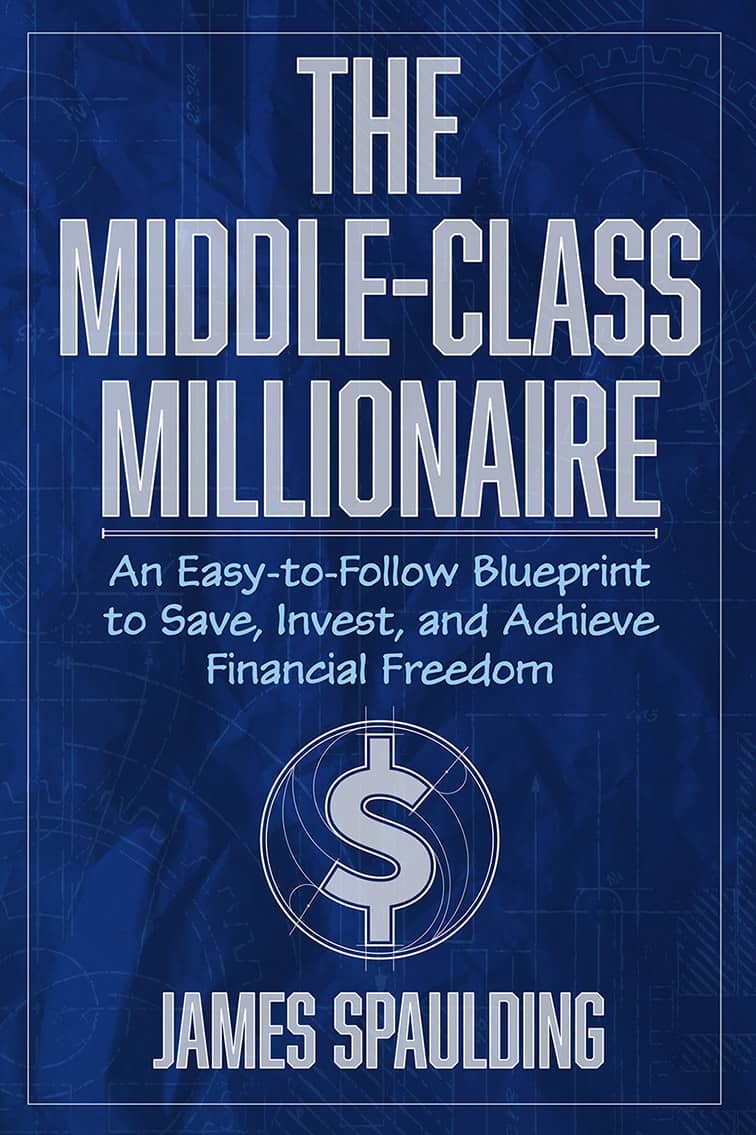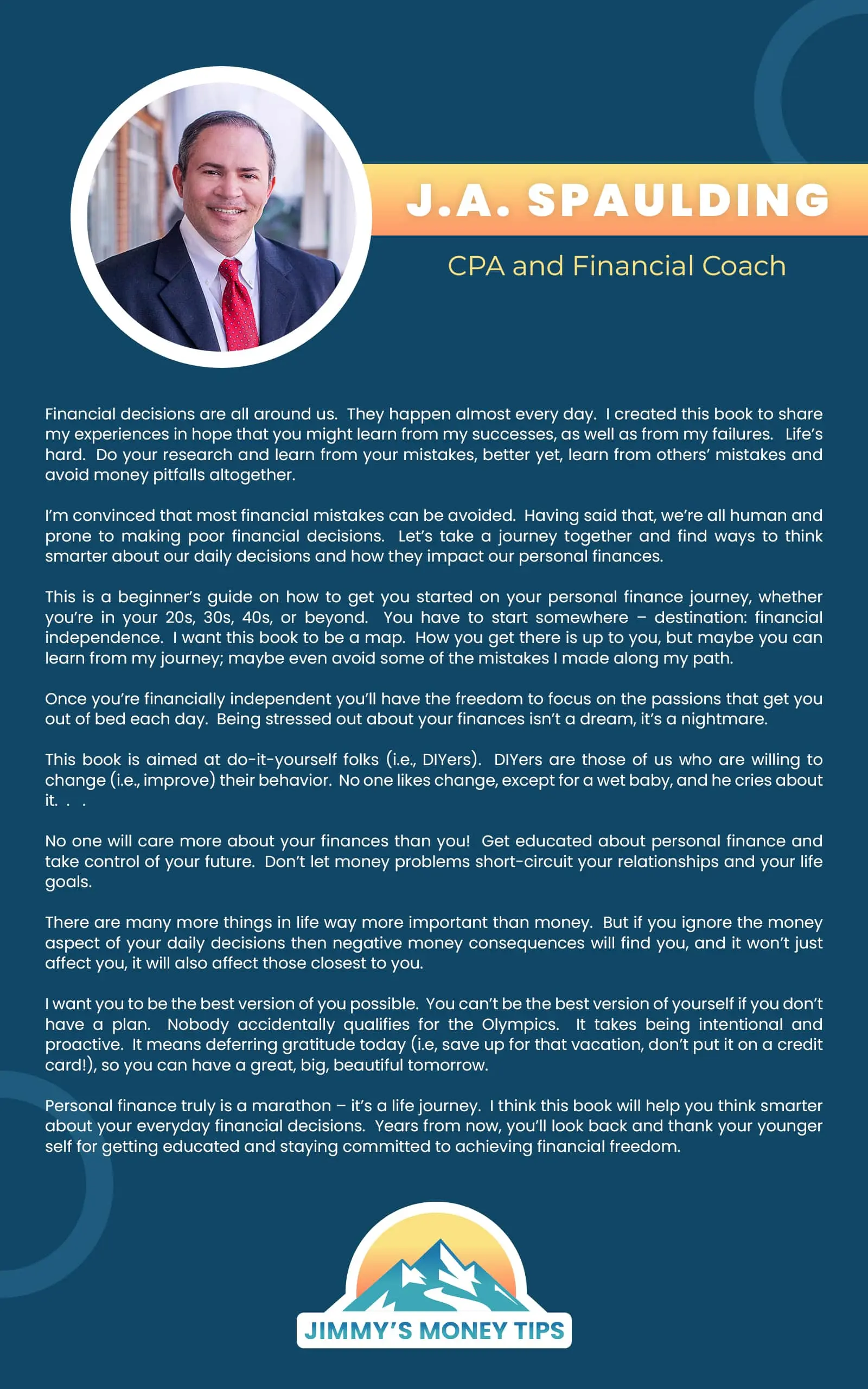Build A Secure Financial Future
Don’t take advice from someone who isn’t already where you want to be in life. Would you listen to a fitness trainer who is 400 pounds overweight? Listen to someone who has already reached their destination and is willing to pass along their road to success.
I’m a middle class millionaire and you can follow in my footsteps. By following Jimmy’s 20 money tips you can achieve financial stability and eventually financial freedom, maybe even early retirement.
Let go of financial worries
Eliminate financial stress by making money management easy to understand.
Spend more time doing what you love
I guide individuals to align their money with their values and goals.
Build a secure financial future
I’ll guide you in creating a clear path to financial freedom and life satisfaction.
Are you living paycheck-to-paycheck, or not sure if you’re saving enough for retirement?
By following Jimmy’s 20 money tips you can achieve financial stability, and eventually financial independence, maybe even early retirement.

James “Jimmy” Spaulding
CPA & Financial Coach
I’m James Spaulding, a Russiaville, Indiana native through and through, where my journey — marked by persistence and a dedication to hard work — began.
At just 10 years old, I started delivering newspapers for the Indianapolis Star, an early experience that planted the seeds for a diverse career path. My roles have ranged from lawn care to financial planning and analysis manager, each step fueling my relentless ambition and resolve.
My fascination with personal finance sparked after college upon discovering Larry Burkett’s “Debt-free Living.” Burkett’s enthusiasm for steering others through their financial challenges struck a chord with me, propelling me on a lifelong pursuit to demystify personal finance.
This journey wasn’t just about securing my own fiscal stability; I was driven to share what I learned, teaching personal finance classes and leading Financial Peace University courses.
Now, at the age of 50, I’m proud of the robust savings I’ve accumulated through nothing but hard work — no inheritance here. My goal is to help others find their financial footing. By penning down my learnings and experiences, I offer practical advice to anyone looking to navigate their financial path, regardless of where they are starting from. “The Millionaire Next Door” by Thomas Stanley is a personal favorite, mirroring my belief in the value of living modestly as a means to wealth accumulation.
My life’s story, dotted with a variety of job roles and financial decisions — both wise and errant — connects with a broad audience. My aim isn’t just to educate but to inspire.
Through my writing, I strive to arm readers with the insights and drive needed to march toward financial independence, embracing the mantra that managing your finances well is a journey that can begin at any age.
See Our Packages
What is a Financial Coach?
A person who provides personal finance advice (one-on-one), guidance, education, and feedback for clients. A financial coach has the heart of a teacher. Compensated by clients by a fixed or hourly fee. A financial coach helps DIY investors.
A financial coach does not actively manage investments or make financial decisions for you. They mentor and provide consulting style advice.
Financial Coaching Sessions
Transform your financial future with expert guidance from Jimmy’s Money Tips! Get advice that resonates with your personal needs and benefit from proven strategies that have already built a robust savings account with no shortcuts!




One on One Financial Coaching
Testimonials
Why do I need a financial coach?
You’re living paycheck-to-paycheck and can’t seem to get ahead.
Because financial patterns are difficult to discern when it involves our own behavior.
FAQs
Who might need a personal finance coach?
A. Anyone seeking to verify they’re on the right track and being smart with money;
especially beneficial to anyone living paycheck-to-paycheck or not sure if they’re
saving enough for retirement.
What can I expect from Jimmy’s coaching?
A. Book club style interactive learning sessions, one-on-one (via zoom) with 3 benefits:
- Reviewing Jimmy’s comprehensive personal finance book, chapter by chapter, with interactive learning including personalized Q&A
- Applying these principles to your individual personal situation
- Follow through, this step introduces accountability into the equation, rather than just hoping you eventually get around to getting your finances right.
Why should I choose to work with Jimmy?
A. Because Jimmy is down to earth, experienced, patient, with the heart of a teacher; and can truly help you improve your personal finances.
Who can benefit from a personal finance coach?
A. Anyone willing to change, and improve, their financial behavior to achieve financial stability and eventually financial freedom, maybe even early retirement.
Who is Jimmy’s financial coaching best suited for?
A. Ideally the middle to upper middle class, $50,000 to $200,000 annual household income. If your household income is below this range then increasing income is a top priority. If your household income is above this range then expense management is more likely a top priority.
Who would not benefit from Jimmy’s financial coaching?
A. Those looking for a financial planner to handle all their money decisions for them.
Are you a financial planner?
A. No, a financial coach has the heart of a teacher. A financial coach provides personal finance advice, guidance, education, and feedback. Mentoring and providing consulting style advice rather than making decisions for you.
I’ve worked with other advisors before, and it didn’t really help, why should I work with you?
A. Only 11% of financial advisors offer comprehensive advice. Many financial advisors are really sales people; sometimes only selling one product (e.g., life insurance). No one will care more about your finances than you! Get educated about personal finance and take control of your future.
Do you get commissions from recommending certain investments?
How does a personal finance coach get paid?
A. They are compensated by their clients via an hourly or fixed fee. No commissions or getting a percentage of your assets.
Why would I need a financial coach? I think I’m pretty smart.
A. Because patterns are difficult to discern when it involves our own behavior. We see patterns in others much easier. Ideally this pattern recognition helps people examine the gap between who you are and who you hope to be. That’s the role I’m hoping to provide as your financial coach.


Unlock practical wisdom and heartfelt guidance in every chapter of "The Middle-Class Millionaire. An Easy-to-Follow Blueprint to Save, Invest, and Achieve Financial Freedom."
Sign Up Now
These 5 FREE Resources will surely make an impact to your financial journey.

